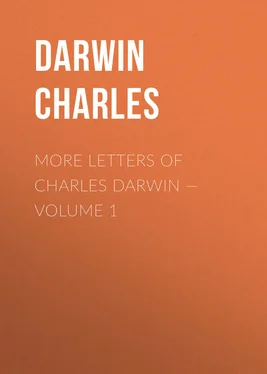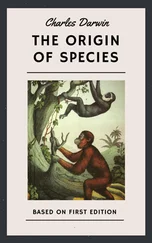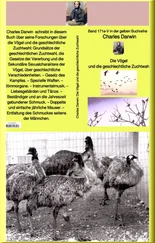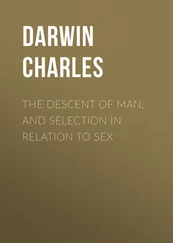Charles Darwin - More Letters of Charles Darwin — Volume 1
Здесь есть возможность читать онлайн «Charles Darwin - More Letters of Charles Darwin — Volume 1» — ознакомительный отрывок электронной книги совершенно бесплатно, а после прочтения отрывка купить полную версию. В некоторых случаях можно слушать аудио, скачать через торрент в формате fb2 и присутствует краткое содержание. Жанр: foreign_antique, foreign_prose, на английском языке. Описание произведения, (предисловие) а так же отзывы посетителей доступны на портале библиотеки ЛибКат.
- Название:More Letters of Charles Darwin — Volume 1
- Автор:
- Жанр:
- Год:неизвестен
- ISBN:нет данных
- Рейтинг книги:4 / 5. Голосов: 1
-
Избранное:Добавить в избранное
- Отзывы:
-
Ваша оценка:
- 80
- 1
- 2
- 3
- 4
- 5
More Letters of Charles Darwin — Volume 1: краткое содержание, описание и аннотация
Предлагаем к чтению аннотацию, описание, краткое содержание или предисловие (зависит от того, что написал сам автор книги «More Letters of Charles Darwin — Volume 1»). Если вы не нашли необходимую информацию о книге — напишите в комментариях, мы постараемся отыскать её.
More Letters of Charles Darwin — Volume 1 — читать онлайн ознакомительный отрывок
Ниже представлен текст книги, разбитый по страницам. Система сохранения места последней прочитанной страницы, позволяет с удобством читать онлайн бесплатно книгу «More Letters of Charles Darwin — Volume 1», без необходимости каждый раз заново искать на чём Вы остановились. Поставьте закладку, и сможете в любой момент перейти на страницу, на которой закончили чтение.
Интервал:
Закладка:
LETTER 4. TO J.S. HENSLOW. Monte Video, 24th November 1832.
We arrived here on the 24th of October, after our first cruise on the coast of Patagonia. North of the Rio Negro we fell in with some little schooners employed in sealing: to save the loss of time in surveying the intricate mass of banks, Capt. Fitz-Roy has hired two of them and has put officers on them. It took us nearly a month fitting them out; as soon as this was finished we came back here, and are now preparing for a long cruise to the south. I expect to find the wild mountainous country of Terra del Fuego very interesting, and after the coast of Patagonia I shall thoroughly enjoy it. — I had hoped for the credit of Dame Nature, no such country as this last existed; in sad reality we coasted along 240 miles of sand hillocks; I never knew before, what a horrid ugly object a sand hillock is. The famed country of the Rio Plata in my opinion is not much better: an enormous brackish river, bounded by an interminable green plain is enough to make any naturalist groan. So Hurrah for Cape Horn and the Land of Storms. Now that I have had my growl out, which is a privilege sailors take on all occasions, I will turn the tables and give an account of my doing in Nat. History. I must have one more growl: by ill luck the French Government has sent one of its collectors to the Rio Negro, where he has been working for the last six months, and is now gone round the Horn. So that I am very selfishly afraid he will get the cream of all the good things before me. As I have nobody to talk to about my luck and ill luck in collecting, I am determined to vent it all upon you. I have been very lucky with fossil bones; I have fragments of at least 6 distinct animals: as many of them are teeth, I trust, shattered and rolled as they have been, they will be recognised. I have paid all the attention I am capable of to their geological site; but of course it is too long a story for here. 1st, I have the tarsi and metatarsi very perfect of a Cavia; 2nd, the upper jaw and head of some very large animal with four square hollow molars and the head greatly protruded in front. I at first thought it belonged either to the Megalonyx or Megatherium (4/1). The animal may probably have been Grypotherium Darwini, Ow. The osseous plates mentioned below must have belonged to one of the Glyptodontidae, and not to Megatherium. We are indebted to Mr. Kerr for calling our attention to a passage in Buckland's "Bridgewater Treatise" (Volume II., page 20, note), where bony armour is ascribed to Megatherium.); in confirmation of this in the same formation I found a large surface of the osseous polygonal plates, which "late observations" (what are they?) show belong to the Megatherium. Immediately I saw this I thought they must belong to an enormous armadillo, living species of which genus are so abundant here. 3rd, The lower jaw of some large animal which, from the molar teeth, I should think belonged to the Edentata; 4th, some large molar teeth which in some respects would seem to belong to an enormous rodent; 5th, also some smaller teeth belonging to the same order. If it interests you sufficiently to unpack them, I shall be very curious to hear something about them. Care must be taken in this case not to confuse the tallies. They are mingled with marine shells which appear to me identical with what now exist. But since they were deposited in their beds several geological changes have taken place in the country. So much for the dead, and now for the living: there is a poor specimen of a bird which to my unornithological eyes appears to be a happy mixture of a lark, pigeon and snipe (No. 710). Mr. MacLeay himself never imagined such an inosculating creature: I suppose it will turn out to be some well-known bird, although it has quite baffled me. I have taken some interesting Amphibia; a new Trigonocephalus beautifully connecting in its habits Crotalus and the Viperidae, and plenty of new (as far as my knowledge goes) saurians. As for one little toad, I hope it may be new, that it may be christened "diabolicus." Milton must allude to this very individual when he talks of "squat like a toad" (4/2. "...him {Satan} there they {Ithuriel and Zephon} found, Squat like a toad, close at the ear of Eve" ("Paradise Lost," Book IV., line 800).
"Formerly Milton's "Paradise Lost" had been my chief favourite, and in my excursions during the voyage of the 'Beagle,' when I could take only a single volume, I always chose Milton" ("Autobiography," page 69).); its colours are by Werner (4/3. Werner's "Nomenclature of Colours," Edinburgh, 1821.) ink black, vermilion red and buff orange. It has been a splendid cruise for me in Nat. History. Amongst the Pelagic Crustacea, some new and curious genera. In the Zoophytes some interesting animals. As for one Flustra, if I had not the specimen to back me up nobody would believe in its most anomalous structure. But as for novelty all this is nothing to a family of pelagic animals which at first sight appear like Medusae but are really highly organised. I have examined them repeatedly, and certainly from their structure it would be impossible to place them in any existing order. Perhaps Salpa is the nearest animal, although the transparency of the body is nearly the only character they have in common. I think the dried plants nearly contain all which were then (Bahia Blanca) flowering. All the specimens will be packed in casks. I think there will be three (before sending this letter I will specify dates, etc., etc.). I am afraid you will groan or rather the floor of the lecture room will when the casks arrive. Without you I should be utterly undone. The small cask contains fish: will you open it to see how the spirit has stood the evaporation of the Tropics. On board the ship everything goes on as well as possible; the only drawback is the fearful length of time between this and the day of our return. I do not see any limits to it. One year is nearly completed and the second will be so, before we even leave the east coast of S. America. And then our voyage may be said really to have commenced. I know not how I shall be able to endure it. The frequency with which I think of all the happy hours I have spent at Shrewsbury and Cambridge is rather ominous — I trust everything to time and fate and will feel my way as I go on.
November 24th. — We have been at Buenos Ayres for a week; it is a fine large city, but such a country, everything is mud, you can go nowhere, you can do nothing for mud. In the city I obtained much information about the banks of the Uruguay — I hear of limestone with shells, and beds of shells in every direction. I hope when we winter in the Plata to have a most interesting geological excursion into that country: I purchased fragments (Nos. 837-8) of some enormous bones, which I was assured belonged to the former giants!! I also procured some seeds — I do not know whether they are worth your accepting; if you think so I will get some more. They are in the box. I have sent to you by the "Duke of York" packet, commanded by Lieut. Snell, to Falmouth two large casks containing fossil bones, a small cask with fish and a box containing skins, spirit bottle, etc., and pill-boxes with beetles. Would you be kind enough to open these latter as they are apt to become mouldy. With the exception of the bones the rest of my collection looks very scanty. Recollect how great a proportion of time is spent at sea. I am always anxious to hear in what state the things come and any criticisms about quantity or kind of specimens. In the smaller cask is part of a large head, the anterior portions of which are in the other large one. The packet has arrived and I am in a great bustle. You will not hear from me for some months.
LETTER 5. TO J.S. HENSLOW. Valparaiso, July 24th 1834.
A box has just arrived in which were two of your most kind and affectionate letters. You do not know how happy they have made me. One is dated December 15th, 1833, the other January 15th of the same year! By what fatality it did not arrive sooner I cannot conjecture; I regret it much, for it contains the information I most wanted, about manner of packing, etc., etc.: roots with specimens of plants, etc., etc. This I suppose was written after the reception of my first cargo of specimens. Not having heard from you until March of this year I really began to think that my collections were so poor, that you were puzzled what to say; the case is now quite on the opposite tack; for you are guilty of exciting all my vain feelings to a most comfortable pitch; if hard work will atone for these thoughts, I vow it shall not be spared. It is rather late, but I will allude to some remarks in the January letter; you advise me to send home duplicates of my notes; I have been aware of the advantage of doing so; but then at sea to this day, I am invariably sick, excepting on the finest days, at which times with pelagic animals around me, I could never bring myself to the task — on shore the most prudent person could hardly expect such a sacrifice of time. My notes are becoming bulky. I have about 600 small quarto pages full; about half of this is Geology — the other imperfect descriptions of animals; with the latter I make it a rule only to describe those parts or facts, which cannot be seen in specimens in spirits. I keep my private Journal distinct from the above. (N.B. this letter is a most untidy one, but my mind is untidy with joy; it is your fault, so you must take the consequences.) With respect to the land Planariae, unquestionably they are not molluscous animals. I read your letters last night, this morning I took a little walk; by a curious coincidence, I found a new white species of Planaria, and a new to me Vaginulus (third species which I have found in S. America) of Cuvier. Amongst the marine mollusques I have seen a good many genera, and at Rio found one quite new one. With respect to the December letter, I am very glad to hear the four casks arrived safe; since which time you have received another cargo, with the bird skins about which you did not understand me. Have any of the B. Ayrean seeds produced plants? From the Falklands I acknowledged a box and letter from you; with the letter were a few seeds from Patagonia. At present I have specimens enough to make a heavy cargo, but shall wait as much longer as possible, because opportunities are not now so good as before. I have just got scent of some fossil bones of a MAMMOTH; what they may be I do not know, but if gold or galloping will get them they shall be mine. You tell me you like hearing how I am going on and what doing, and you well may imagine how much I enjoy speaking to any one upon subjects which I am always thinking about, but never have any one to talk to {about}. After leaving the Falklands we proceeded to the Rio S. Cruz, following up the river till within twenty miles of the Cordilleras. Unfortunately want of provisions compelled us to return. This expedition was most important to me as it was a transverse section of the great Patagonian formation. I conjecture (an accurate examination of fossils may possibly determine the point) that the main bed is somewhere about the Miocene period (using Mr. Lyell's expression); I judge from what I have seen of the present shells of Patagonia. This bed contains an ENORMOUS field of lava. This is of some interest, as being a rude approximation to the age of the volcanic part of the great range of the Andes. Long before this it existed as a slate and porphyritic line of hills. I have collected a tolerable quantity of information respecting the period and forms of elevations of these plains. I think these will be interesting to Mr. Lyell; I had deferred reading his third volume till my return: you may guess how much pleasure it gave me; some of his woodcuts came so exactly into play that I have only to refer to them instead of redrawing similar ones. I had my barometer with me, I only wish I had used it more in these plains. The valley of S. Cruz appears to me a very curious one; at first it quite baffled me. I believe I can show good reasons for supposing it to have been once a northern straits like to that of Magellan. When I return to England you will have some hard work in winnowing my Geology; what little I know I have learnt in such a curious fashion that I often feel very doubtful about the number of grains {of value?}. Whatever number they may turn out, I have enjoyed extreme pleasure in collecting them. In T. del Fuego I collected and examined some corallines; I have observed one fact which quite startled me: it is that in the genus Sertularia (taken in its most restricted form as {used} by Lamoureux) and in two species which, excluding comparative expressions, I should find much difficulty in describing as different, the polypi quite and essentially differed in all their most important and evident parts of structure. I have already seen enough to be convinced that the present families of corallines as arranged by Lamarck, Cuvier, etc., are highly artificial. It appears that they are in the same state {in} which shells were when Linnaeus left them for Cuvier to rearrange. I do so wish I was a better hand at dissecting, I find I can do very little in the minute parts of structure; I am forced to take a very rough examination as a type for different classes of structure. It is most extraordinary I can nowhere see in my books one single description of the polypus of any one coralline excepting Alcyonium Lobularia of Savigny. I found a curious little stony Cellaria (5/1. Cellaria, a genus of Bryozoa, placed in the section Flustrina of the Suborder Chilostomata.) (a new genus) each cell provided with long toothed bristle, these are capable of various and rapid motions. This motion is often simultaneous, and can be produced by irritation. This fact, as far as I can see, is quite isolated in the history of zoophytes (excepting the Flustra with an organ like a vulture's head); it points out a much more intimate relation between the polypi than Lamarck is willing to allow. I forgot whether I mentioned having seen something of the manner of propagation in that most ambiguous family, the corallines; I feel pretty well convinced if they are not plants they are not zoophytes. The "gemmule" of a Halimeda contained several articulations united, ready to burst their envelope, and become attached to some basis. I believe in zoophytes universally the gemmule produces a single polypus, which afterwards or at the same time grows with its cell or single articulation.
Читать дальшеИнтервал:
Закладка:
Похожие книги на «More Letters of Charles Darwin — Volume 1»
Представляем Вашему вниманию похожие книги на «More Letters of Charles Darwin — Volume 1» списком для выбора. Мы отобрали схожую по названию и смыслу литературу в надежде предоставить читателям больше вариантов отыскать новые, интересные, ещё непрочитанные произведения.
Обсуждение, отзывы о книге «More Letters of Charles Darwin — Volume 1» и просто собственные мнения читателей. Оставьте ваши комментарии, напишите, что Вы думаете о произведении, его смысле или главных героях. Укажите что конкретно понравилось, а что нет, и почему Вы так считаете.












